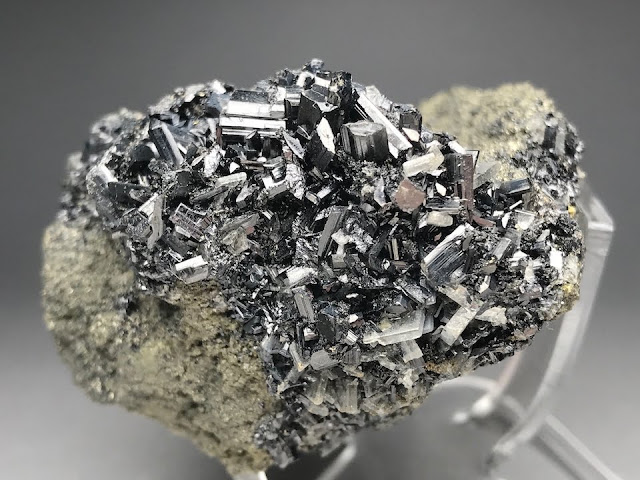小坂の硫砒銅鉱 Enargite from Kosaka
標本幅 width 5.5 cm / 重さ weight 269 g
黒鉱鉱床中に硫砒銅鉱(Cu3AsS4)を主とする脈が生じて、長さ 5 mm くらいの柱状結晶が多数着生した。重晶石の結晶もみられる。母岩は黄鉄鉱主体のいわゆる黄鉱。柱の端面(c面)がきれいに出ているものが多い(屋根型・ドーム型になる場合もある。末尾の結晶図を参照)。そしてそのc面の形が唇のシルエットみたいにひしゃげていて、かつそのひしゃげ具合が厚い唇、薄い唇みたいに一定していないのが特徴的である。堀秀道「楽しい鉱物図鑑2」(草思社、1997)に、硫砒銅鉱の結晶は「独特の風格というか、一種の愛嬌があり、一度見ると忘れない」という記述があった。確かに輝安鉱(Sb2S3; なんとなく威厳がある)とか車骨鉱(PbCuSbS3; スター性が感じられる)なんかとは一味違っていて、わからなくもない。
An enargite vein formed in a kuroko-type deposit mainly composed of pyrite ("yellow" ore) and many prismatic crystals of around 5 mm in length grew with baryte. The top surface is mostly flat and its shape is deformed like a silhouette of lips, some being thick and others thin. Hidemichi Hori wrote in his book that enargite crystal was very unique and cannot be forgotten. Enargite gives an impression different from stibnite and bournonite and there would be reasons he thought so.
地質調査所編の "Introduction to Japanese Minerals"(1970)には、日本が世界に誇る(?)特筆すべき鉱物として50種が紹介されているが、硫砒銅鉱もそのうちのひとつ。長野県海瀬村(現・佐久穂町)からは長さ 4 cm に達する大結晶が出たし、また北海道の手稲鉱山からは柱状結晶の端面に黄銅鉱の微結晶がエピタキシャル成長して美麗な輝きをみせる珍品が出た。ここ小坂のような黒鉱型の鉱床でも硫砒銅鉱はめずらしくない。日本鉱物誌・第3版上巻(中文館書店、1947)にはおとなり大館市花岡鉱山や青森県大間町の奥戸鉱山産の例が載っていて、長さ 0.5 〜 1 cm の柱状結晶が出たとある。黒鉱鉱山は塊状で見栄えのしない鉱石を掘り出しただけのヤマではない。
英名のエナージャイトは「(へき開が)明瞭な」というギリシャ語由来だそうで、とくに m(110) の面に沿って薄くはがれるという(たとえば加藤昭「主要鉱物各説」無名会、2017)。入手したてで(東京・白山のコムロミネラルズにて)まだもったいないが、そのうち実験してみたい。
In "Introduction to Japanese Minerals" edited by Geological Survey of Japan in 1970, there is a list of 50 minerals that are world-class in some senses, and enargite is one of them. A big enargite crystal of 4 cm in length was found from Kaize village (now Sakuho city), Nagano prefecture. A prismatic crystal from Teine mine, Hokkaido, is rare in that the top surface shows a golden glitter due to epitaxial growth of chalcopyrite film. A kuroko-type deposit often contains enargite; e.g., Kosaka, as shown in the above, and Hanaoka (Odate city, Akita) and Okoppe (Oma town, Aomori), where prismatic crystals measuring to 1 cm were found as described in "Wada's minerals of Japan" (3rd edition, 1947). Enargite is named after a Greek word referring to "distinct" cleavage particularly parallel to m(110) surface. I would like to make sure of it by experiment, but still hesitate to pick up and break a crystal from this newly bought (at Komuro Minerals, Hakusan, Tokyo) specimen.
From "Wada's minerals of Japan" (3rd edition, 1947).
参考
東北大学総合学術博物館所蔵の標本(No. 19、秋田県大館市花岡鉱山産、写真)。





